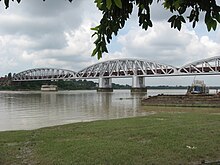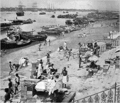Hooghly River
| Hooghly River Bhagirathi | |
|---|---|
Ganga | |
Rabindra Setu (Howrah Bridge) Nivedita Setu Vivekananda Setu (Bally bridge) Sampreeti Bridge Jubilee Bridge Ishwar Gupta Setu Gourango Setu Nashipur Rail Bridge Ramendra Sundar Tribedi Setu Jangipur Bhagirathi Bridge | |
The Hooghly River (Anglicized alternatively spelt as Hoogli or Hugli) or popularly called
The river flows through the
The Hooghly has religious significance as Hindus consider the river sacred. The river also plays a major role in the agriculture, industry, and climate of the state.
Course
The vast majority of the water that flows into the Hooghly River is provided by the man-made

Tidal bore

The tide runs rapidly on the Hooghly, and produces a remarkable example of the fluvial phenomenon known as a
History
In its upper reaches the river is generally known as the Bhāgirathi, until it reaches Hooghly. The word Bhāgirathi literally means "caused by Bhagiratha", a Hindu mythological Solar dynasty prince who was instrumental in bringing the river Ganges from heaven to the earth, in order to release his 60,000 grand-uncles from a curse of the saint Kapila.[10]
In 1974, the Farakka Barrage began diverting water into the Hooghly during the dry season so as to reduce the silting difficulties at Kolkata's port.
Like the rest of the Ganges, the Bhāgirathi-Hooghly is considered sacred to
Bridges and tunnels

The following bridges currently span the Hooghly/Bhagirathi River; listed from south to north (mouth to source), until the Farakka Feeder Canal meets the river:
- Vidyasagar Setu (Second Hooghly Bridge)- inaugurated in October 1992, connecting Howrah and Kolkata
- Rabindra Setu (Howrah Bridge) - inaugurated in February 1943, connecting Howrah and Kolkata
- Nivedita Setu (Second Vivekananda Bridge) - inaugurated in July 2007, connecting Bally and Dakhineswar; runs adjacent to Vivekananda Setu
- Vivekananda Setu (Bally Bridge; road and rail bridge) - inaugurated in December 1932, connecting Bally and Dakhineswar; runs adjacent to Nivedita Setu
- Sampreeti Setu (New Jubilee Bridge; rail only) - inaugurated in August 2016, connecting Bandel and Naihati; replaced the now-decommissioned Jubilee Bridge
- Ishwar Gupta Setu (Kalyani Bridge) - inaugurated in 1989, connecting Bansberia and Kalyani
- Gouranga Setu - connecting Nabadwip and Krishnanagar
- Ramendra Sundar Tribedi Setu - connecting Khagraghat and Baharampur[12]
- Jangipur Bhagirathi Bridge - connecting Jangipur

The following bridges are under various stages of development:
- Nashipur Rail Bridge (rail only) - partially constructed; connecting Azimganj and Murshidabad
- New Bhagirathi Bridge - Connecting NH 34 between Basudev Khali and Haridasmati, Berhampore
- Kalna - Shantipur Bridge[13] - announced[14]
- Fuleshwar - Budge Budge Bridge[13] - announced
The following tunnels are situated under the Hooghly River :-
- CESC Tunnel - This tunnel is using for electric power transmission between Kolkata and Howrah. It was the first underwater tunnel of Asia. The construction of this tunnel was completed in 1931.[15]


- East West Metro Tunnel - The tunnel was completed in 2021. This tunnel is the first underwater river railway tunnel in India. It is a metro railway tunnel, connecting Kolkata to Howrah.
Economics

The Bhāgirathi-Hooghly river system is an essential lifeline for the people of West Bengal. It was through this river that the East India company sailed into Bengal and established their trade settlement, Calcutta, the capital of British India. People from other countries such as the French, Dutch, Portuguese, etc. all had their trade settlements by the banks of this river.
The river provides a perennial supply of water to the plain of West Bengal for irrigation and human & industry consumption. The river is navigable and a major transport system in the region with a large traffic flow. For a long time, the Calcutta Port was the biggest port of India. Although in the past its significance had gone down, recently it has reached the 3rd position in the list of Indian Ports. The modern container port of Haldia, on the intersection of lower Hooghly and Haldi River, now carries much of the region's maritime trade. One new port will be built in the deep sea to reduce the load on Calcutta port.

Despite the river being polluted, the fish from it are important to the local economy.

The Hooghly river valley was the most important industrial area of the state of Bengal. Despite a decline of the
In September 2015, the Government of West Bengal announced that renovation of the Hooghly riverfront in Kolkata will be completed with the help of World Bank funding under the National Ganga River Basin Project Scheme.[16]
Hooghly River in arts


Literature
Rudyard Kipling wrote an article, On the Banks of the Hugli (1888),[17] and a short story set on the Hooghli, An Unqualified Pilot (1895).[18]
Cultural events
The Silk River project aims at exploring the artistic relationship between Kolkata and

Gallery
-
Boats on Hooghly River
-
Hooghly River in Kolkata
-
Boats and men on the banks of the Hooghly river, 1915
-
The Floatel in Kolkata located on the river
-
The Prinsep Ghat which is located on the bank of the Hooghly River
-
Char on the river at Bansberia, Hooghly district
-
Boats on the river at Shimurali, Nadia district
-
The river behind Hazarduari Palace in Murshidabad district
-
The city of Kolkata lies along the banks of the Hooghly
-
Boat seen from the bank of the Hoogly River at Kolkata
See also
References
- ^ The river is locally called Ganga because it is one of the two distributaries of the Ganges and is hence considered to be sacred. The Puranas call this arm of the Ganges, the Ganges itself. Some more modern sources, relying entirely on the scriptures, suggest that this river is the Ganga itself, 'Hoogly' being just a regional nickname. However, there is no scientific basis of this claim. 1, 2
- ^ The Editors of Encyclopedia Britannica (5 August 2010). "Bhagirathi River". Britannica. Retrieved 3 June 2023.
- JSTOR 4298836.
- ^ "District". Voiceofbengal.com. Archived from the original on 11 November 2014. Retrieved 10 May 2012.
- ^ "Hugli River". Encyclopædia Britannica. Archived from the original on 5 June 2016. Retrieved 8 July 2016.
- ^ https://archive.org/details/ainiakbarivolum00mubgoog The Ain I Akbary Abul Fazl Allammi Vol-2, Translated by Colonel H.S.Jarrett published by The Asiatic Society of Bengal Printed at the Baptist Mission Press in 1891 Calcutta page-120.
- ^ https://cclpworldwide.com/wp-content/uploads/2020/03/Hooghly-Jelar-Itihas-Sudhir-Kumar-Mitra.pdf Archived 23 March 2020 at the Wayback Machine Jelar Itihas Sudhir Kumar Mitra/ page no 792 (original book) internet page 806
- ^ Chakraborty, Satyesh C. "The Story of River Port". Kolkata Port Trust. Archived from the original on 2011-07-21. Retrieved 2007-12-10.
- ^ a b Helen Schreider; Frank Schreider (October 1960). "From The Hair Of Siva". National Geographic. 118 (4): 445–503.
- ISBN 978-1-4406-2327-1.
- ^ "What is the origin of holy river Ganga?". 20 March 2020. Archived from the original on 23 March 2020. Retrieved 23 March 2020.
- ^ "সেতুর হালে বাড়ছে আতঙ্ক". Retrieved 14 May 2024.
- ^ a b "Three river bridges in WB to boost trade, highlight culture". The Indian Express. 6 October 2017. Archived from the original on 12 March 2018. Retrieved 12 March 2018.
- ^ "Construction of bridge over river Bhagirathi connecting Kalna, ch.35.447 km of STKK road and Shantipur, ch.96.30 km of NH 34 in the district of Purba Bardhaman & Nadia, Project Length 14.476 Km, length of main bridge including ROB 2.114 Km in Nadia , Purba Bardhaman (West Bengal): Project Updates & Investment Details | IIG". indiainvestmentgrid.gov.in. Retrieved 14 May 2024.
- ^ "Kolkata Metro: 87 years on, boring re-creates CESC feat". The Times of India. 18 April 2017. Archived from the original on 22 September 2022. Retrieved 29 September 2022.
- ^ "World Bank to fund Hooghly riverfront revamp - Times of India". The Times of India. 3 September 2015. Archived from the original on 7 September 2015. Retrieved 3 September 2015.
- ^ "Chapter IV - City of Dreadful Night - From Sea to Sea - Rudyard Kipling, Book, etext". Telelib.com. 1 February 2003. Archived from the original on 3 March 2016. Retrieved 25 August 2013.
- ^ "An Unqualified Pilot - Land & Sea Tales - For Scouts and Guides - Rudyard Kipling, Book, etext". Telelib.com. 1 March 2003. Archived from the original on 5 April 2016. Retrieved 25 August 2013.
- ^ Chatterjee, Chandreyee (10 November 2016). "Exploring the River Connect". No. Kolkata. ABP. The Telegraph. Archived from the original on 15 January 2018. Retrieved 21 July 2017.
- ^ Basu, Anasuya (21 July 2017). "River Walk to Boost Ties". No. Kolkata. ABP. The Telegraph. Archived from the original on 15 January 2018. Retrieved 21 July 2017.
- This article incorporates text from a publication now in the public domain: Chisholm, Hugh, ed. (1911). "Hugli (river)". Encyclopædia Britannica (11th ed.). Cambridge University Press.
1. Gautam Kumar Das. 2024. River Systems of West Bengal: Water Quality and Environment. In: River Systems of West Bengal. Springer Water. Springer, Cham. 180p. https://doi.org/10.1007/978-3-031-53480-5-1. https://link.springer.com/book/10.1007/978-3-031-53480-5.
2. Gautam Kumar Das. 2015. Estuarine Morphodynamics of the Sunderbans, Springer, Switzerland, 211p. https://doi.org/10.1007/978-3-319-11343-2. https://link.springer.com/book/10.1007/978-3-319-11343-2.










